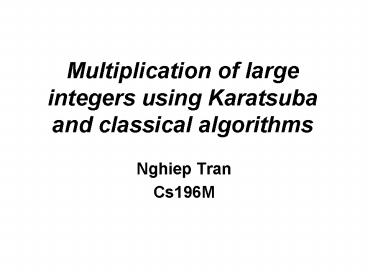Multiplication of large integers using Karatsuba and classical algorithms - PowerPoint PPT Presentation
Title:
Multiplication of large integers using Karatsuba and classical algorithms
Description:
Multiplication of large integers using Karatsuba and classical algorithms Nghiep Tran Cs196M – PowerPoint PPT presentation
Number of Views:129
Avg rating:3.0/5.0
Title: Multiplication of large integers using Karatsuba and classical algorithms
1
Multiplication of large integers using Karatsuba
and classical algorithms
- Nghiep Tran
- Cs196M
2
School multiplying
- 2412
- x 3231
- -------
- 2412
- 7236
- 4824
- 7236
- ---------------
- 7793172
3
Karatsuba Multiplication (Divide-and-conquer
multiplication)
- by Karatsuba and Ofman (1962)
- aL aR aaL, aR ,b bL,
bR - x bL bR aL left half of
number a - ----------------- aR right half
of number a - aLbR aRbR bL left half
of number b - aLbL aRbL bR right half of number b
- ---------------------------------
- aLbL (aLbR aRbL) aRbR
4
Karatsuba Multiplication (Divide-and-conquer
multiplication)
- ab aL bL 10n (aL bR aR bL) 10n/2 aR bR
- x1 aL bL
- x2 aR bR
- x3 (aL aR) (bL bR)
- ab x1 10n (x3 - x1 - x2) 10n/2 x2
- aL bL 10n ((aL bL aL bR aR bL aR
bR) - aL bL - - aRbR) 10n/2 aRbR
- aLbL10n (aL bR aR bL) 10n/2 aR bR
5
Example
- ab aL bL 10n (aL bR aR bL) 10n/2 aR bR
- 1026 7329
- aL 10, aR 26 bL 73, bR 29 n 4
- 1026 7329
- 1073104 (1029 2673)102 2629
- 730104 2188 102 754
- 7519554
6
School
- Void school(int num1, int num2, int result,
int len) - int i, j
- for(i 0 i lt 2 len i)
- resulti 0
- for(i 0 i lt len i)
- for(j 0 j lt len j)
- resulti j num1i num2j
7
Karatsuba
- BigInteger multiply(BigInteger a, BigInteger
b) - int n max(number of digits in a, number of
digits in b) - if(n 1)
- return a b
- else
- BigInteger aR bottom n/2 digits of
a - BigInteger aL top remaining digits
of a - BigInteger bR bottom n/2 digits of
b - BigInteger bL top remaining digits
of b - BigInteger x1 Multiply(aL, bL)
- BigInteger x2 Multiply(aR, bR)
- BigInteger x3 Multiply(aL bL, aR
bR) - return x1 pow(10, n) (x3 - x1 -
x2) pow(10, n / 2) x2
8
Result
digits 8 16 32 64 128 256 512 1024 School 0.004423 0.011863 0.036895 0.127891 0.485230 1.831810 7.201439 28.628571 Karatsuba 0.004538 0.012674 0.036854 0.105385 0.317778 0.937266 2.846591 8.483051
9
Graph
10
Implementation
- The karatsuba() will reverts to school() function
when number of digits is less than CUTOFF_VALUE
since karatsuba() is slower than school() for
small values of n. - Carries are deferred until after the
multiplication is complete. - Avoid allocating memory. This saves the overhead
of continually allocating arrays.
11
Analysis
- Grade school O(n2)
- Karatsuba T(n) 3T(n/2) dn
- O(nlg3)O(n1.585)
- Split each of numbers into two halves each with
n/2 digits. - Recursively multiply 4 pairs of n/2 digits
numbers.-? O(n2) same as school - Clever way reduce the number of n/2 digit
multiplication from 4 to 3.
12
Conclusion
- Why would one want to multiply 100 digit numbers
with exact precision? - Cryptography applications
- RSA
- Largest prime
- FFT (Fast Fourier Transform) based algorithm -
"Knuth algorithm" - Schonhage and Strassen in 1971































